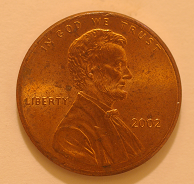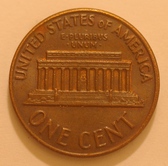
A science project about the Lincoln Cent? Sure. After all, science is
all around us in all aspects of our lives. One great benefit of this experiment
is that the cost is literally pennies !! Before we begin, the coin is technically
called a cent. Look at the reverse side ( the 'tails' side). 
Now we can get a rough idea of its volume. The penny is a cylinder with an
extremely low height. As with all cylinders, the formula is:
VOLUME = Pi * (Radius)2 * height
VOLUME = 3.14159 * 9.5 * 9.5 * 1.27
VOLUME = 360 cubic millimeters = .360 cubic centimeters.
You can recheck these figures - or recheck your own calculations - by going to
the cylinder calculator.
An even more precise way for measuring the volume would be to use a measuring
cup, a graduated cylinder or anything else used for measuring volume.
 If you
use a measuring cup, make sure it is NEVER going to be used with food!! If you
use a measuring cup, make sure it is NEVER going to be used with food!!
 Please, no experiments with any food
related equipment. Please, no experiments with any food
related equipment. Okay now what? Well, fill the cup (or whatever) to a certain point with water and drop in a penny to see the volume rise. Of course the volume change would be minuscule. So, like the ruler experiment, why not drop in a great deal of pennies (remembering exactly how many you used), see the volume difference, divide it by the number of pennies, and you have the volume! If the volume is in Fluid Ounces and you want it in cubic centimetrs, just use the Ultra Converter.
So, what is the mass of a penny? Well, an interesting change took place in
1982. Prior to that year, pennies were 95% Copper and 5% zinc. After 1982
the composition became 97.6% zinc and 2.4% copper. (1982 pennies can be
either one of these. Oh and in 1943 pennies were made of a steel & zinc
combination but we won't concern ourselves with those). So, the point is
that pre-1982 pennies will have a different mass than pennies made after
1982. So, how about 'weighing' (determining the mass) of some pennies.
First, we will have to construct a crude scale. One way is to hang a plastic
disposable cup from a rubber band and attach it vertically to a ruler.
(Again, don't just take our suggestions. Perhaps you could find your own
method of 'weighing' the pennies).
Now we must use a 'standard' mass and the best substance for that would be
water. Fill the cup with 100 milliliters (cubic centimeters) of water. This
has a mass of 100 grams. (Remember the point on the ruler the cup reaches).
Now empty the cup of water and fill it up with pre-1982 pennies until the
cup reaches the same point as when you had it filled with water. The number
of pennies in the cup will have a mass of 100 grams. (In case you are
wondering, the number of pre-1982 pennies that equal 100 grams is about 32.(So each
of these pennies has a mass of 3.1 grams). (However, do the experiment yourself).
Now do the same with pennies made after 1982. (This will be about 40 pennies and so
each of these pennies has a mass of about 2.5 grams).
Okay, you have now determined the size and the mass of pennies.
Now time to move on to density.
Density is defined by the formula:
Density = Mass ÷ Volume
(Not to confuse you anymore, but a lot of people use specific gravity and density
interchangeably. However, specific gravity refers to the density of a substance
compared to water - grams per cubic centimeter. (Almost always,
densities are expressed this way but it is important to know the difference).
You have determined that a penny's volume is .360 cubic centimeters and the
mass is 3.1 grams (pre-1982) and 2.5 grams (after 1982). So the densities
are:
Now is there any way to verify your findings? Sure. For all intents and purposes
we could say that pre-1982 pennies are all copper and the ones after 1982 are
all zinc. Now looking up the densities we find Copper = 8.96 and Zinc = 7.13.
Pretty good agreement wouldn't you say?
Get a pre-1982 penny and drop it on the floor or on concrete or on a table, etc
(but DON'T start scratching any furniture in the process). Anyway, did you
notice the distinctive 'pinging' sound a copper penny makes? Now drop a penny made
after 1982. The sound is much 'duller' isn't it? Why don't you research about
copper and zinc to find out why this is so?
 ⚠ DO NOT DO THIS EXPERIMENT YOURSELF !!!! ⚠ ⚠ DO NOT DO THIS EXPERIMENT YOURSELF !!!! ⚠ 
 ⚠ POSSIBILITY OF SKIN BURNS & FIRE HAZARD !!!!! ⚠ ⚠ POSSIBILITY OF SKIN BURNS & FIRE HAZARD !!!!! ⚠
 Melting Point of Copper = 1,083°Celsius (=1,981°Fahrenheit) As we can see from above, there is a huge difference between the melting point of zinc and copper. So much of a difference that a zinc penny can be melted in a Bunsen burner but a copper penny cannot. To try this, we recommend clamping the penny with an alligator clip and holding that with pliers or Vise Grips™. The zinc penny will easily melt in the Bunsen burner flame. The copper penny will certainly get hot, it will even start to glow but it WON'T melt. We were patient enough to be able to melt a zinc penny in a candle flame. (This takes a while, is very sooty and smelly so be forewarned).
(In scientific notation that's 2.8 x 1022atoms).
Good luck with the project !!!
|
|||||||